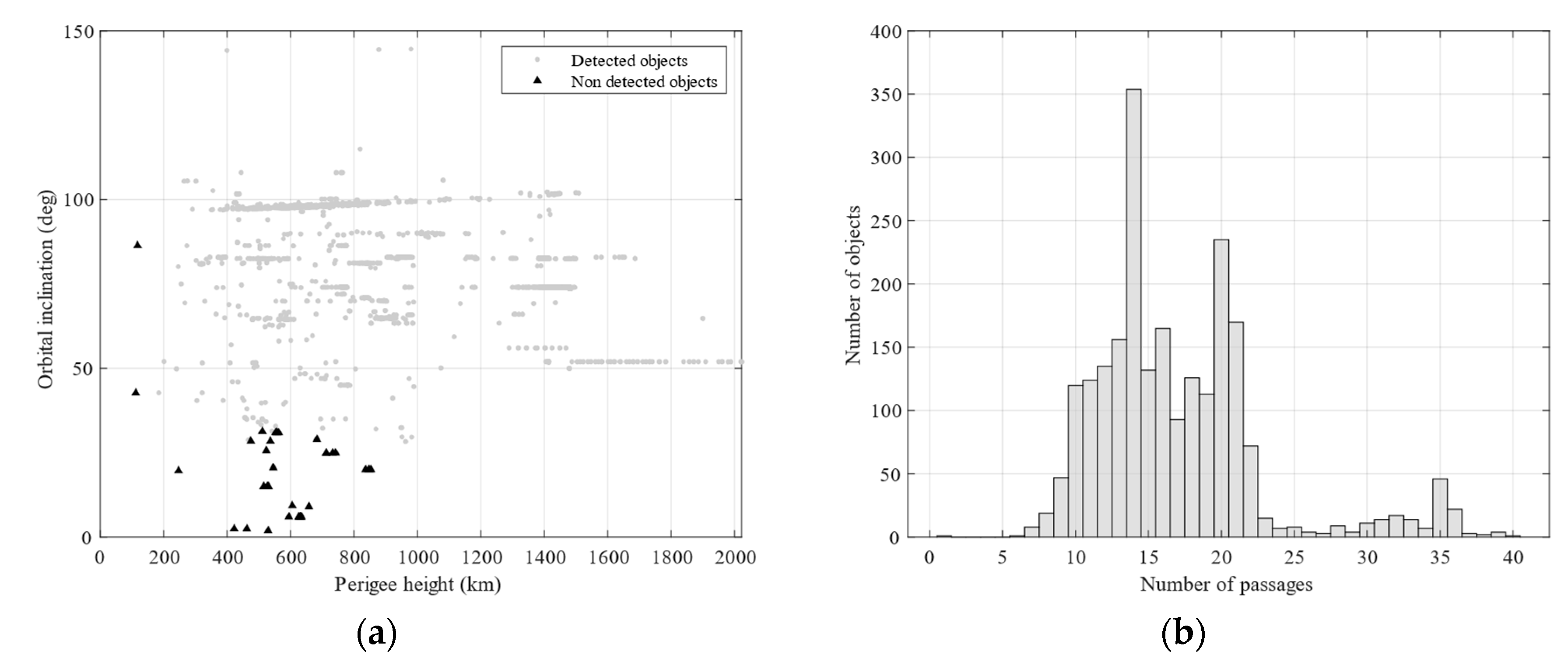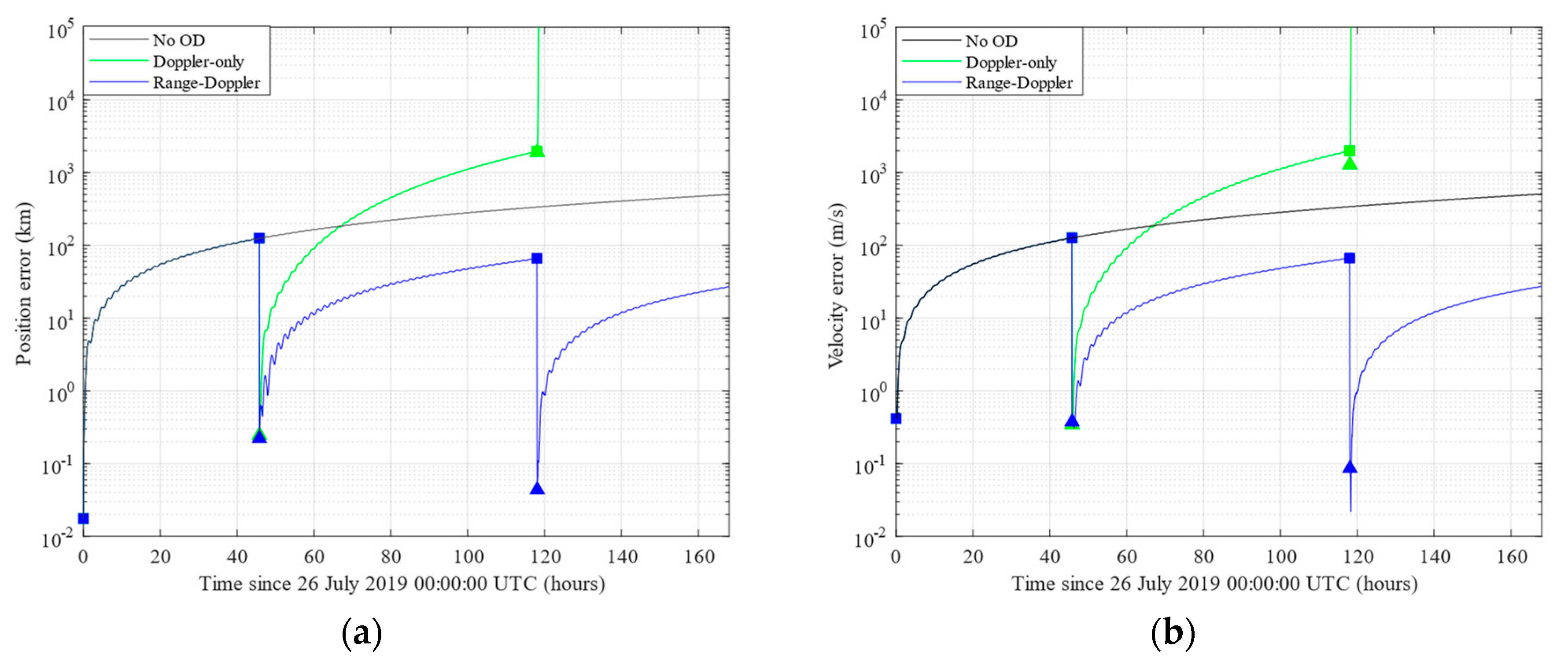Orbit Determination of Resident Space Objects Using the P-Band Mono-Beam Receiver of the Sardinia Radio Telescope
Abstract
:1. Introduction
2. The SRT as a Receiver in a Bi-Static Radar Configuration
3. Numerical Simulations
3.1. Observation Capabilities
3.2. Orbit Determination Refinement
- Sigma points computation
- Time update
- Measurement update
4. Conclusions
Author Contributions
Funding
Acknowledgments
Conflicts of Interest
References
- Muntoni, G.; Schirru, L.; Pisanu, T.; Montisci, G.; Valente, G.; Gaudiomonte, F.; Serra, G.; Urru, E.; Ortu, P.; Fanti, A. Space Debris Detection in Low Earth Orbit with the Sardinia Radio Telescope. Electronics 2017, 6, 59. [Google Scholar] [CrossRef]
- Klinkrad, H. The Current Space Debris Environment and its Sources. In Space Debris—Models and Risk Analysis; Springer: Berlin/Heidelberg, Germany, 2006; pp. 5–58. [Google Scholar]
- Weeden, B.; Cefola, P.; Sankaran, J. Global Space Situational Awareness Sensors. In Proceedings of the Advanced Maui Optical and Space Surveillance (AMOS) Conference, Maui, HI, USA, 14–17 September 2010. [Google Scholar]
- Vallado, D.A.; Griesbach, J.D. Simulating Space Surveillance Networks. In Proceedings of the AAS/AIAA Astrodynamics Specialist Conference, Girdwood, AK, USA, 31 July–4 August 2011. [Google Scholar]
- Masekell, P.; Lorne, O. Sapphire: Canada’s Answer to Space-Based Surveillance of Orbital Objects. In Proceedings of the Advanced Maui Optical and Space Surveillance (AMOS) Conference, Maui, HI, USA, 16–19 September 2008. [Google Scholar]
- Piergentili, F.; Ceruti, A.; Rizzitelli, F.; Cardona, T.; Battagliere, M.L.; Santoni, F. Space Debris Measurement Using Joint Mid-Latitude and Equatorial Optical Observations. IEEE Trans. Aerosp. Electron. Syst. 2014, 50, 1. [Google Scholar] [CrossRef]
- Ender, J.; Leushacke, L.; Brenner, L.; Wilden, H. Radar Techniques for Space Situational Awareness. In Proceedings of the IEEE International Radar Symposium (IRS), Leipzig, Germany, 7–9 September 2011. [Google Scholar]
- Markkanen, J.; Lehtinen, M.; Landgraf, M. Real-time space debris monitoring with EISCAT. Adv Space Res. 2005, 35, 1197–1209. [Google Scholar] [CrossRef]
- Mehrholz, D.; Leushacke, L.; Jehn, R. The COBEAM-1/96 Experiment. Adv. Space Res. 1999, 23, 23–32. [Google Scholar] [CrossRef]
- Wilden, H.; Kirchner, C.; Peters, O.; Ben Bekhti, N.; Brenner, A.; Eversberg, T. GESTRA—A Phased-Array Based Surveillance and Tracking Radar for Space Situational Awareness. In Proceedings of the IEEE International Symposium on Phased Array Systems and Technology (PAST), Waltham, MA, USA, 18–21 October 2016. [Google Scholar]
- Losacco, M.; Di Lizia, P.; Massari, M.; Mattana, A.; Perini, F.; Schiaffino, M.; Bortolotti, C.; Roma, M.; Naldi, G.; Pupillo, G.; et al. The multibeam radar sensor BIRALES: Performance assessment for space surveillance and tracking. In Proceedings of the 69th International Astronautical Congress (IAC), Bremen, Germany, 1–5 October 2018. [Google Scholar]
- Pisanu, T.; Schirru, L.; Urru, E.; Gaudiomonte, F.; Ortu, P.; Bianchi, G.; Bortolotti, C.; Roma, M.; Muntoni, G.; Montisci, G.; et al. Upgrading the Italian BIRALES System to a Pulse Compression Radar for Space Debris Range Measurements. In Proceedings of the 22nd International Microwave and Radar Conference (MIKON), Poznan, Poland, 14–17 May 2018. [Google Scholar]
- Muntoni, G.; Schirru, L.; Montisci, G.; Pisanu, T.; Valente, G.; Ortu, P.; Concu, R.; Melis, A.; Saba, A.; Gaudiomonte, F.; et al. A Space Debris Dedicated Channel for the P-Band Receiver of the Sardinia Radio Telescope. IEEE Antennas Propag. Mag. in press.
- Schirru, L.; Muntoni, G.; Pisanu, T.; Urru, E.; Valente, G.; Gaudiomonte, F.; Ortu, P.; Melis, A.; Concu, R.; Bianchi, G.; et al. Upgrading the Sardinia Radio Telescope to a Bistatic Tracking Radar for Space Debris. In Proceedings of the 1st IAA Conference on Space Situational Awareness (ICSSA), Orlando, FL, USA, 13–15 November 2017. [Google Scholar]
- Tapley, B.D.; Schutz, B.E.; Born, G.H. Statistical Orbit Determination; Elsevier Academic Press: San Diego, CA, USA, 2004. [Google Scholar]
- Vallado, D.A.; Hujsak, R.S.; Johnson, T.M.; Seago, J.H.; Woodburn, J.W. Orbit Determination using ODTK version 6. Available online: https://www.researchgate.net/publication/277238110_Orbit_Determination_Using_ODTK_Version_6 (accessed on 23 September 2019).
- ExoAnalytic solutions. Available online: https://exoanalytic.com/space-situational-awareness/ (accessed on 23 September 2019).
- Bolli, P.; Orlati, A.; Stringhetti, L.; Orfei, A.; Righini, S.; Ambrosini, R.; Bartolini, M.; Bortolotti, C.; Buffa, F.; Buttu, M.; et al. Sardinia Radio Telescope: General Description, Technical Commissioning, and First Light. J. Astron. Instrum. 2015, 4, 1–20. [Google Scholar] [CrossRef]
- Bolli, P.; Olmi, L.; Roda, J.; Zacchiroli, G. A Novel Application of the Active Surface of the Shaped Sardinia Radio Telescope for Primary-Focus Operations. IEEE Antennas Wirel. Propag. Lett. 2014, 13, 1713–1716. [Google Scholar] [CrossRef]
- Schirru, L.; Pisanu, T.; Navarrini, A.; Urru, E.; Gaudiomonte, F.; Ortu, P.; Montisci, G. Advantages of Using a C-band Phased Array Feed as a Receiver in the Sardinia Radio Telescope for Space Debris Monitoring. In Proceedings of the IEEE 2nd Ukraine Conference on Electrical and Computer Engineering (UKRCON), Lviv, Ukraine, 2–6 July 2019. [Google Scholar]
- Valente, G.; Pisanu, T.; Bolli, P.; Mariotti, S.; Marongiu, P.; Navarrini, A.; Nesti, R.; Orfei, A.; Roda, J. The Dual Band L-P Feed System for the Sardinia Radio Telescope prime focus. In Millimeter, Submillimeter, and Far-Infrared Detectors and Instrumentation for Astronomy V, Proceedings of SPIE Astronomical Telescopes + Instrumentation, San Diego, CA, USA, 15 July 2010; International Society for Optics and Photonics: San Diego, CA, USA, 2010; p. 774126. [Google Scholar]
- Nicolini, L.; Caporali, A. Investigation of Reference Frames and Tim Systems in Multi-GNSS. Remote Sens. 2018, 10, 80. [Google Scholar]
- Wan, E.; Van Der Merwe, R. Chapter 7: The Unscented Kalman Filter. In Kalman Filtering and Neural Networks; Wiley: New York, NY, USA, 2001; pp. 221–280. [Google Scholar]






| Optics | Gregorian (Shaped) + BWG |
|---|---|
| Focal Positions | Primary: f/D = 0.33 |
| Gregorian: f/D = 2.34 | |
| 2 x BWG I: f/D = 1.38 | |
| 2 x BWG II: f/D = 2.81 | |
| Frequency Range | 0.3 − 116 GHz |
| Primary Reflector Diameter | 64 m |
| Secondary Reflector Diameter | 7.9 m |
| BWG Mirrors Diameter | 2.9 − 3.9 m |
| Azimuth and Elevation Speed (wind speed < 60 km/h) | 0.85 °/s (Az) |
| 0.5 °/s (El) | |
| Azimuth and Elevation Range pointing | 5 ÷ 90° (Az) |
| −270° ÷ +270° (El) | |
| Antenna Gain at 410 MHz | 46.6 dBi |
| Antenna Efficiency at 410 MHz | 57.7% |
| Half Power Beam Width (HPBW) at 410 MHz | 0.8° |
| System noise temperature | about 25 K |
| System noise power | about −100 dBm |
| Typical received SNR level | >10 dB |
| Epoch (UTC) | ||||||||
|---|---|---|---|---|---|---|---|---|
| 26/07/2019 00:00:00 | - | - | - | - | 1.76e-2 | 2.45e-1 | 4.16e-1 | 1.73 |
| 27/07/2019 21:46:25 | - | - | - | - | 1.26e2 | 5.01e2 | 1.27e2 | 5.08e2 |
| 27/07/2019 21:48:09 | 2.46e-1 | 2.86 | 3.41e-1 | 4.17 | 1.26e2 | 5.01e3 | 1.27e2 | 5.08e2 |
| 28/07/2019 21:48:09 | 2.35e2 | 1.80e3 | 2.39e2 | 1.83e3 | 1.93e2 | 7.63e2 | 1.96e2 | 7.74e2 |
| 29/07/2019 21:48:09 | 8.82e2 | 3.76e3 | 9.01e2 | 3.82e3 | 2.62e2 | 1.03e3 | 2.66e2 | 1.04e3 |
| 1.76e3 | 3.19e3 | 1.74 | 3.11 | 4.80e2 | 1.85e3 | 4.47e-1 | 1.83 | 1.72 | 1.74 |
| 1.19e2 | 1.98e2 | 1.15e-1 | 1.91e-1 | 4.81e2 | 1.85e3 | 4.47e-1 | 1.83 | 1.09e-1 | 1.09e-1 |
© 2019 by the authors. Licensee MDPI, Basel, Switzerland. This article is an open access article distributed under the terms and conditions of the Creative Commons Attribution (CC BY) license (http://creativecommons.org/licenses/by/4.0/).
Share and Cite
Losacco, M.; Schirru, L. Orbit Determination of Resident Space Objects Using the P-Band Mono-Beam Receiver of the Sardinia Radio Telescope. Appl. Sci. 2019, 9, 4092. https://doi.org/10.3390/app9194092
Losacco M, Schirru L. Orbit Determination of Resident Space Objects Using the P-Band Mono-Beam Receiver of the Sardinia Radio Telescope. Applied Sciences. 2019; 9(19):4092. https://doi.org/10.3390/app9194092
Chicago/Turabian StyleLosacco, Matteo, and Luca Schirru. 2019. "Orbit Determination of Resident Space Objects Using the P-Band Mono-Beam Receiver of the Sardinia Radio Telescope" Applied Sciences 9, no. 19: 4092. https://doi.org/10.3390/app9194092





